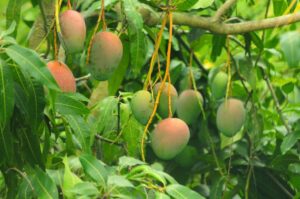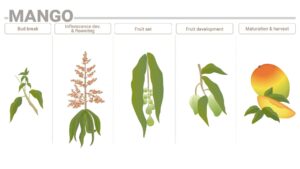Three different foliar treatments were tested in an eight years old ‘Haden’ mango orchard. The trees were planted on a sandy loam soil with a neutral pH at 4 m x 4 m in an orchard located at the Central University of Venezuela in Maracay, Venezuela. The effect of two urea sprays (0,5%) combined with two KNO3 sprays (60 g/L), two potassium thiosulphate (4% PTS) sprays combined with two KNO3 sprays (60 g/L) and three KNO3 sprays on the vegetative and floral growth as studied (Figure 1).
At 130 days after the first application the first flowering branches were observed after treatment T4. This treatment included one more foliar application with potassium nitrate compared to T2 and T3. Flowering is associated to ethylene production, coming from a large synthesis of methionine, due to a larger nitrate-reductase enzyme activity. KNO3 can contribute to this effect. In general all foliar applications of potassium nitrate strengthened the flowering induction compared to the untreated control T1 (Figure 1). At 210 days after the first application a higher percentage of flowering branches (not statistically significant) and more total branches (significant at p<0,05) were recorded for treatment T3: alternating foliar sprays with PTS or KNO3. The authors recommend treatment T3 for mango orchard management in Venezuela, because of the improved balance between flowering and vegetative growth.

Figure 1. Treatment effects on the percentage of flowering branches and the total percentage of developed (flowering+vegetative) branches, 210 days after the first nutrient spray application.



